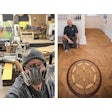

I have observed over my years as a hardwood flooring contractor that just because I have become proficient at installing, sanding, staining and finishing hardwood floors, those skills are separate from the skills necessary to become proficient at landing jobs.
I once heard a gentleman who worked in the field of business marketing speak. He said, “Telling isn’t selling. If you find out what people want, and give it to them, you will get their business.”
Since I receive many times more inquiries for work than I can physically perform, I screen calls as they come in by asking how they heard about my company, where they live, how soon they would like to have the work performed, and if they are very price-sensitive. For years, I have not advertised and have done remodel work purely by word of mouth.
One response to me asking the homeowner over the phone if they were price-sensitive is particularly memorable. She replied, “Yeah, I’m extremely price-sensitive. I’ve got 700 square feet of oak that needs resurfacin’. One contractor said he’d do it for a buck a square foot. Then my neighbor said he would do it for 400 and a suitcase of beer. I’m just wantin’ to know if you can get under his price…”
Needless to say, I didn’t make the 45-minute commute to meet up with that gal. I told her no, thanked her for calling, and bid her good day. The point being, asking some questions up front has saved me a fair amount of time and wear and tear on a vehicle, when it can be discovered over the telephone that potential clients and my company are—for sure—not compatible.
For those that do qualify over the phone, I believe building rapport with these potential clients plays a huge factor in the overall success of the job. One of the first opportunities to build rapport is to show up on time to the estimate. I was raised in a family that pulled up to appointments 5 to 10 minutes early. This habit still serves me well today. It gives me a chance to clear my clipboard of everything but one blank sheet of paper and a couple of my business cards, line up a writing utensil, clip my moisture meter to one pocket and my tape measure to the other, grab my photo album, and ring the doorbell on time. Before walking up to the door, I write down the name of the homeowner(s), the date of the estimate, their address, their phone number (and email address if I have it), and who referred them.
While I’m at this estimate, my one and only focus is on them.
There is a reason I have this one sheet and one sheet only of paper, with their information written down on my clipboard: While I’m at this estimate, my one and only focus is on them.
While another flooring contractor from out of state was working with me on a job in Colorado years ago, we were unexpectedly stopped behind an accident on the way to an estimate early one morning before going to our job site to work for the day. We were due at the estimate at 7 a.m., so I called at 6:55 and informed the homeowner that we would be three minutes late. She thanked me for the call, and said she would see us when we arrived.
The other contractor riding with me asked if that is really necessary. My response was it is absolutely necessary. With no call from us, at 7:01, the homeowner might be checking the time of the estimate, confirming it was supposed to be at 7:00. At 7:02, they may be wondering if we had vehicle trouble, or maybe we forgot, or if there was some other sort of complicating factor. At 7:03, the thought may cross their mind that if we don’t show up on time and don’t call for something as simple as an estimate, how in the world are we going to be able to perform the entire scope of work on time? Once we finally arrive and ring the doorbell, we’re possibly just the guys that aren’t going to land the job no matter what.
After arriving on time at an estimate and making the acquaintance of the homeowner(s), I ask the question, “How can I be of service?”
Then, I zip it. I close my lips, and I listen. I have listened so intently at this stage that on a few occasions, I have begun to sweat.
Recent example:
“So you see, Keith, the refrigerator manufacturer had a faulty valve, and since then there have been recalls. They say they will pay for the damages. The adjustor came out and is telling us since this floor was sanded on site when the house was new, that we need to sand this entire main level down. Is that true? Oh, and one more thing, do the boards that are cupped up need to be replaced? Oh, and can you give us an option for those wooden vents so that we can get rid of these metal ones? We counted, we’ve got fourteen of them. Oh yeah, and can you give us an option for getting rid of the carpet on the stairs and that landing going to our upstairs to replace it with hardwood to match the floor? Oh, and also, do the baseboards need to be removed? If so, do you do that? We were thinking about going from this natural color to a medium brown stain. Can you do that? Do you use water-based finish? That’s what this is, and we like it. I think it’s a satin sheen, we would like it to be a satin sheen again. We have an indoor cat—do we need to do anything special with her while you’re staining and finishing? If we put her in the basement with food, water, and a litter box, will the fumes affect her in a bad way? We can make arrangements to take her somewhere if need be. Do you have to remove the toilet in the bathroom to sand the flooring in there? Oh, and what about us? Can we be living here while you’re doing the work? How bad does the stain smell? Do you move furniture? Oh, and how long is the job going to take? Can the furniture be set back right away when you’re done? Oh yeah, and how far out are you booked?”
I take shorthand notes on my one sheet of paper, and let them ask as many questions in a row as they like. I have found that if questions posed by homeowners are like a stream of consciousness, being fired off one after another, it’s most fruitful to wait until all questions are asked before attempting to answer any of them. If I jump straight into the intricacies of what to do with cupped boards, and homeowners are having questions come to mind about something else, it will be difficult for them to focus on what I am explaining.

Once all questions have been asked and addressed, then and only then do I hand them a photo album of past jobs I have completed. I say, “Alright, I believe I understand the scope of work now. While I’m measuring the floor, here are some pictures of jobs I’ve completed for other clients.”
Physically handing potential clients a book of printed out photos does several things. One, it is a great way to build rapport, as I’m demonstrating that I care greatly about the work I perform. Two, it shows that I go above and beyond, since I went to the trouble to go track down a photo album, print off pictures and present them neatly. Three, it demonstrates my level of craftsmanship. Four, it begins the process of me giving them something and them receiving it, just as will happen when I give them a service and they receive it should they choose to hire my company to perform the work in their home. Five, it gives homeowners something to do while I measure other than be underfoot, or wondering if they should be holding the end of the tape measure “to help out.”

I view each estimate as an opportunity to exchange information. I do not view it as a one-way street in which I am throwing spaghetti against the wall, hoping some of it will stick. I implement the quality over quantity approach. I prefer to be thorough and extremely attentive on the small handful of estimates I choose to do. As a result, I land the vast majority of them.
Once all measurements are taken, I tell them what it will cost on the spot, right there in their home while we’re still together. I write it down on the back of one of my business cards and hand it to them. I also offer to email them the figures, to which most people say yes, and they give me an email address. This is another great way to build rapport. I make a commitment to them that I will follow up with an email by say, 7:00 that evening the same day. Then, I do it. After addressing them by name in the email, and identifying who I am and my company name, I type, “As promised, here is the email confirmation for the quote to perform work in your home at…”
I make a promise, and keep it to show up to the estimate on time. Then, I make a promise, and keep it to follow up with a black-and-white email confirmation on time. For many potential clients, my company’s habit of doing what it claims it will do, in the time frame it said it would do it, overcomes the fact that my company’s bid is generally not the lowest of all they receive, and many times we still land the job.
In talking with other hardwood flooring contractors throughout the country, I have gotten the impression that many other locales have more companies all vying for the same business. In other words, more competitive than where I am located here in Colorado. In my region, I am appalled by how often I hear from clients something along the lines of, “Well, Keith, looks like your company is the one. We enjoyed having you by to measure, and were likely going to go with you anyway, but get this—we called eight different flooring contractors, and only five of you called back. Of you five, all agreed to come out for an estimate, but only three of you showed up. Of you three, your company was the only one who actually gave us a bid. So, you’re it! What’s your earliest availability?”
If we’re the only one to throw our hat in the ring, it makes landing jobs fairly straightforward. For those times when there is a bit more competition for homeowners to choose from, it’s my sincere hope that the above specifics of what I do pertaining to the subject of bidding are helpful.
I invite discussion in the comments section below. I’m curious if any of you all run into the same things described above, if you bring a photo album along on estimates, if your region is competitive or chill, et cetera.
Stay sharp!
































